This was published 6 years ago
Putrajaya, Malaysia's administrative capital: Travel guide to a sci-fi city immersed in jungle
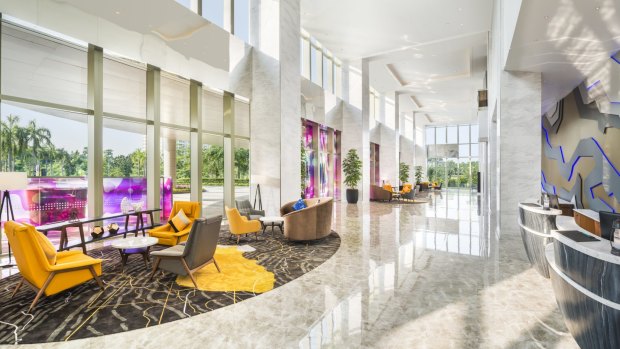
Lobby of the Le Meridien.
From the back of a taxi, the approach to Putrajaya reveals a tangle of highways that loop past palm trees and golf courses. Occasionally buildings soar in fountains of glass that coruscate in the tropical glare. There are no hawker stalls or ramshackle repair shops; not even any people. Putrajaya seems like an abandoned sci-fi city slowly being taken over by jungle. My driver is happy, though. The roads are immaculate and, freed of Kuala Lumpur's tailgating traffic, the taxi surges forward.
As we pull into Le Meridien Putrajaya, the city's eerie emptiness is replaced by sudden bustle. The cheerful hotel puts me in a good mood from the moment I step into its lobby, splotched with light from huge coloured windows. Chirpy staff are welcoming and helpful. Tourists clutter the cafe, and flocks of ladies in pink headscarves twitter in the lift.
This busy happiness makes me pause. Tourists dwell all too often on the old, but locals are often more uplifted by the new. In my room I stand by the window and a splendid vision of the future unfolds: a manicured Malaysia of office blocks, swank hotels and pretty parks. This federal territory, high-tech business district and administrative capital of Malaysia, to which the government made its official move in 1999, couldn't be a more startling contrast to the shabby chaos of parts of Kuala Lumpur.
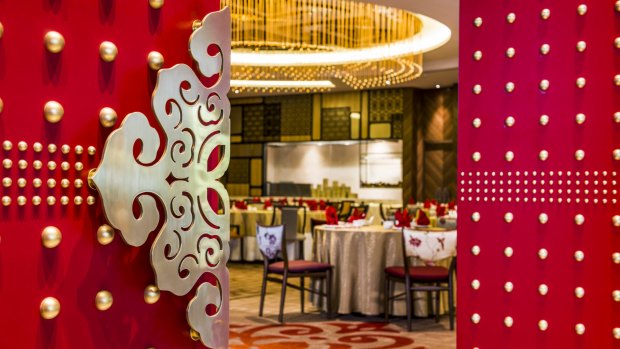
Le Mei Chinese restaurant at the Le Meridien Putrajaya hotel.
Putrajaya is mid-way between Kuala Lumpur (25 kilometres) and KLIA international airport (20 kilometres), making it a convenient stopover on arrival or departure from Malaysia. Its buxom hills and large lake make me think of Canberra, though the hills here are lush and the climate humid. Putrajaya is well planned, beautifully landscaped, dotted with quiet residential neighbourhoods that most of the world can only dream of living in. It pushes well beyond Canberra in the scale of its buildings, however. This is more Dubai in the tropics, careless of air-conditioning and budgets, and wanton with eye-popping architecture.
My overnight is a convenience for an early-morning flight but has another benefit, since I'll discover Putrajaya's grand lakeshore architecture is particularly striking under evening illuminations. Many people take to a 45-minute sightseeing lake cruise to admire the urban vistas and exotic-looking bridges. That afternoon, though, I find that Putra Perdana Park, high point of the city centre, provides just as good panorama of the greenery and monumental buildings that characterise the city. Down on the nearby lakeshore, Putrajaya Botanical Garden is abundant with flowers, though its tree-top walk isn't yet enveloped in the still-growing canopy of young trees.
Later I discover another good vantage point on the lakeshore outside the small, classical China-Malaysia Friendship Garden. It has great views towards the silvery-metallic Besi Mosque. The contemporary wire mesh that encases this building recalls Islamic latticework. The mosque seems to float on the lake like a cubic steel flower.
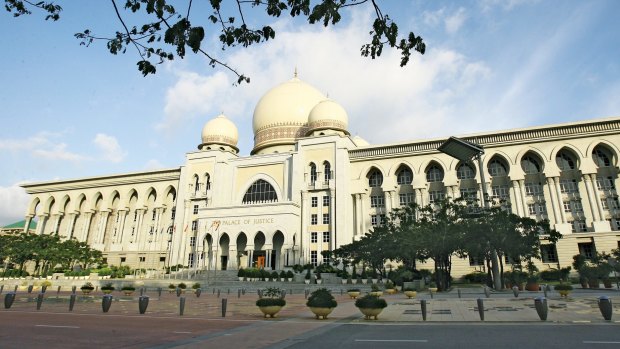
Palace of Justice.
The capital's biggest mosque is further along, flanked by a rocket-like minaret, one of the world's tallest. The granite used in Putra Mosque's construction is the colour of cooked salmon, inlaid with white stone. Putra Mosque is loosely modelled on 16th-century Safavid architecture from Iran. I find it odd and bulky until the late afternoon sun catches it, turning it a gorgeous hue. The courtyard inside feels rather Zen, and the interior of the dome is a neck-cricking beauty.
Much of Putrajaya's architecture is Islamic inspired and sometimes lurches towards the Aladdinesque. Beside Putra Mosque, just across flag-fluttered Dataran Putra square, Perdana Putra houses the prime minister's office and sports a mosque-like dome atop a clash of Moghul and Palladian architecture. It sets the tone for the grandiose, pastiche style of Putrajaya's government departments. Some buildings are beautiful, others bludgeon you with bulk. In between, the city presents the leafy greenery so lacking in Kuala Lumpur, as well as unclogged roads, pleasant water vistas and cycle paths. Putrajaya also offers a string of special events such as major sporting competitions and garden, fireworks and hot-air-balloon festivals.
Back at my hotel, I take the opportunity to plunder IOI City Mall next door. It has 350 retail outlets, a cinema, a skating rink and a kids' theme park. Then I repair to my hotel's Le Mei Chinese restaurant for dinner. More than any other Asian city, Putrajaya is a place whose dining scene is focused on hotels.
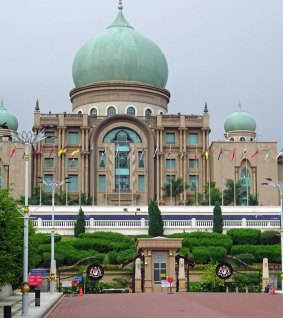
The prime minister's office.
Le Mei has predictable Chinese decor, but I detect an inventive flair in the fusion flavours of its dishes. Among delectable dim-sum entrees are shrimp dumplings with pepper-seared foie gras, and bean-curd rolls deep fried with cheddar cheese. Mains include wok-seared Aussie beef and lamb, Sichuan-style seafood and Hong Kong noodles. I settle on the noodles and wisely leave room for chilled mango puree with vanilla ice cream, sago and pomelo.
When I peer out my guestroom window again, Putrajaya has fallen into a dark silence. Like many planned cities, it has its troubles luring people to live here. Some deride it as soulless. Question is, what will it be like 100 years hence? Besides, I find myself rather taken with this strange place.
Creating a whole new capital from scratch takes audacity and energy. My visit to Malaysia has been a round of Perenakan museums, British colonial-era leftovers and dilapidated Chinese shophouses. I'm glad I've stopped by Putrajaya and been presented with another side of Malaysia, looking firmly to the future.
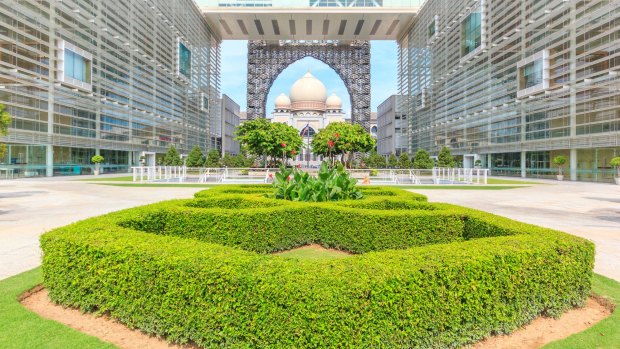
Palace of Justice or the Istana Kehakiman.Credit: iStock
See also: What to do in Kuala Lumpur - the three-minute guide
FIVE OTHER PLANNED CAPITALS
Putrajaya joins an odd list of other recent planned capitals, including Abuja in Nigeria and Naypyidaw in Myanmar. Others have been around a little longer. Here are a famous five.
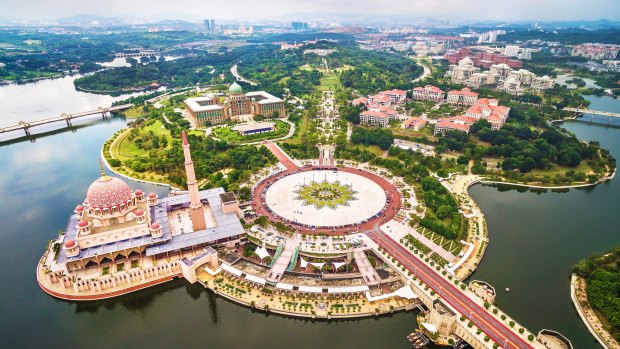
Carefully planned: Masjid Putra, or Pink Mosque, in Putrajaya, near Kuala Lumpur.Credit: iStock
BRASILIA, BRASIL
Brazil moved its capital from Rio in 1960. It offers some of the world's best contemporary architecture, particularly those designed by Oscar Niemeyer, master of modernism, set in superb landscaping by designer Roberto Burle Marx. It's worth touring the interior of the foreign-affairs Palacio do Itamaraty, one of many impressive government departments along Eixo Monumental. The white marble-and-glass Metropolitan Cathedral resembles a luminous jellyfish.
See visitbrasil.com
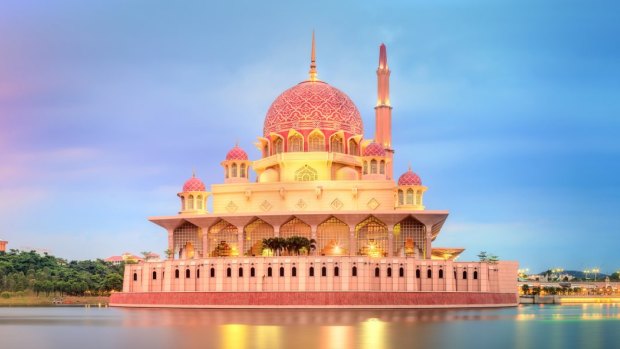
Sunset over Putrajaya Mosque.Credit: iStock
NEW DELHI, INDIA
Though several dynasties made Delhi their capital, the British added a further layer when they moved here in 1911. The grand avenue Rajpath is the anchor for its many monumental buildings in salmon pink, designed by British architects Edwin Lutyens and Herbert Baker – no better place to be for the fabulous Republic Day (26 January) parade. Leafy residential neighbourhoods and sedate museums spread nearby. See delhitourism.gov.in
WASHINGTON DC, US
The Americans created their new capital from 1790. Like many planned cities, it features big avenues radiating outwards from circular intersections, set within landscaped parks. The ceremonial core of the city is beautiful, studded with white marble monuments and memorials and blushing with cherry blossoms in springtime. Good on-trend dining, great shopping and some of the world's best museums are other reasons to visit. See washington.org
ST PETERSBURG, RUSSIA
Though replaced as the capital in 1918, St Petersburg was planned in 1712 to present an open, progressive European-style city in contrast to Moscow. Baroque and neoclassical buildings and churches line a series of canals and grid-work streets that provide some of the world's finest urban vistas. St Petersburg remains the cultural capital of Russia, rich in art museums, theatres, ballet companies and magnificent palaces. See visit-petersburg.ru
ASTANA, KAZAKHSTAN
Astana replaced Almaty as capital in 1997. It positions itself as the Singapore of the steppes but is far less sedate. Bonkers buildings include the Bayterek observation tower (which resembles a soccer trophy), the giant glass Pyramid of Peace and the tent-like Khan Shatyr Entertainment Centre. If you want to see a 21st-century city on steroids and seemingly without budget restraints, there's no wackier place. See visitkazakhstan.kz
See also: 10 weird capital cities you didn't know about
TRIP NOTES
MORE
STAY
Guestrooms at Le Meridien Putrajaya have unfussy chic and are spacious; generous bathrooms feature both shower and tub. Apart from Le Mei Chinese restaurant, buffet lunch and dinner venue Latest Recipe has an impressive range of quality Malaysian, pan-Asian and western dishes. Phone 1800 450 010. See lemeridienputrajaya.com
FLY
Malaysia Airlines flies from Adelaide, Darwin, Melbourne, Perth and Sydney to Kuala Lumpur International Airport, 20 kilometres from Putrajaya by taxi or express train. Phone 13 26 27. See malaysiaairlines.com
Brian Johnston travelled as a guest of Malaysia Airlines, Tourism Malaysia and Le Meridien Putrajaya.
Sign up for the Traveller Deals newsletter
Get exclusive travel deals delivered straight to your inbox. Sign up now.